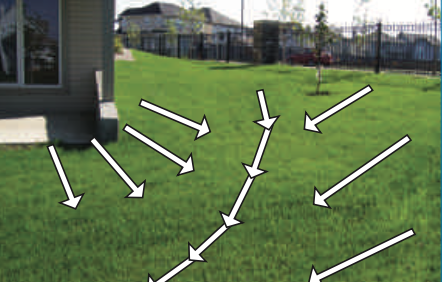When I am out estimating, I am watching out for drainage issues around people’s homes. New lots are subject to a grade inspection, ( see final grade ) but older lots have sometimes developed problems over the years due to ground settling. Other issues like improper downspouts or flow from neighbouring properties can become a serious problem given the right rain storm, potentially causing thousands of dollars in damage.

Curbing can actually be used to mitigate some drainage problems, but the key thing is always proper lot grading and maintenance of eavestroughs and downspouts, sump drains and other drainage features.
We can build in splash pads and gutters in some cases. We can put various types of bypass into the curb to allow water past so that we don’t get puddling near the house where there is a risk. Also when there is a major swale planned into the lot grading, we generally put a “dip” into the curb so large flows of surface water can drain over the curb. Even though these dips or cuts are not perfectly attractive, they are better than the alternative of using weep holes. Weep holes through the curb are not a wise idea, as they will eventually plug up and be forgotten, potentially causing a drainage problem. If you see a drainage concern we have not spotted, by all means mention it preferably prior to curb installation!
If you have a need for a water drain over the curb, you can cut a notch using a skill saw or angle grinder with a cheap masonry blade available at home improvement centres. Cut a notch about 2″ wide partially through the curb. Do this by making several parallel cuts close together and chip the slivers of concrete away with a hammer to make a wide channel. The end cuts can angle in toward each other so they are not so blunt, and you can touch up sharp edges so they are smoothed off a bit. Then if its a stamped curb, simply brush some sealer over the spot, and the colour will blend reasonably well, because the base colour of the concrete goes all the way through.
Some people panic too easily about puddling of water behind a curb. In my opinion, it is not a problem to have a puddle laying a couple of hours or even a day after a lot of rain- as long as it is not right next to a house foundation!
When lot grading needs to be addressed, it may be time for a more comprehensive look at your flood prevention strategy.
The City of Edmonton has a Flood Prevention Program that may be of help, and should be understood by all homeowners.
.
Did you know you can get a free flood prevention check-up from a qualified specialist if your property is inside the City of Edmonton? You can call 780-944-7777 for more information or to schedule a complimentary appointment.
Some excerpts from the city website: https://www.edmonton.ca/city_government/utilities/flood-prevention-program.aspx

Background
Our city receives about 345 millimetres (14 inches) of rain a year, most of which falls from May to October. Though this is not a huge amount of precipitation, our summer storms tend to drop large amounts of rain over short periods of time. During major rainstorms the sheer volume of water can back up drainage systems and flood basements.
Program
Drainage Planning and Engineering sponsors a Flood Prevention Program to equip homeowners with the information and knowledge to make drainage improvements.
Goals
The Flood Prevention Program is intended to meet 2 objectives:
To reduce risk of basement flooding due to sewer backup during rainfall events.
To reduce wet weather flows in the sanitary sewer system.
Four Key Messages
Downspouts
Downspouts should extend at least 1.8 metres (6 feet) from your basement wall and drain away from the house toward a street or back lane.
Lot Grading
Land should slope outward from the foundation of the house for a minimum of 1.8 metres (6 feet).
Flood-proofing Devices
Individual and neighbourhood drainage systems prone to flooding should have a flood-proofing device, such as a sump pump or backwater valve, installed to keep rainwater and sewage from backing up into basements.
Plumbing Fixtures
A qualified plumber should inspect all plumbing fixtures and flood-proofing devices regularly to make sure they are in good conditions.
Links:
Homeowner’s guide to flood prevention


Comments are closed.